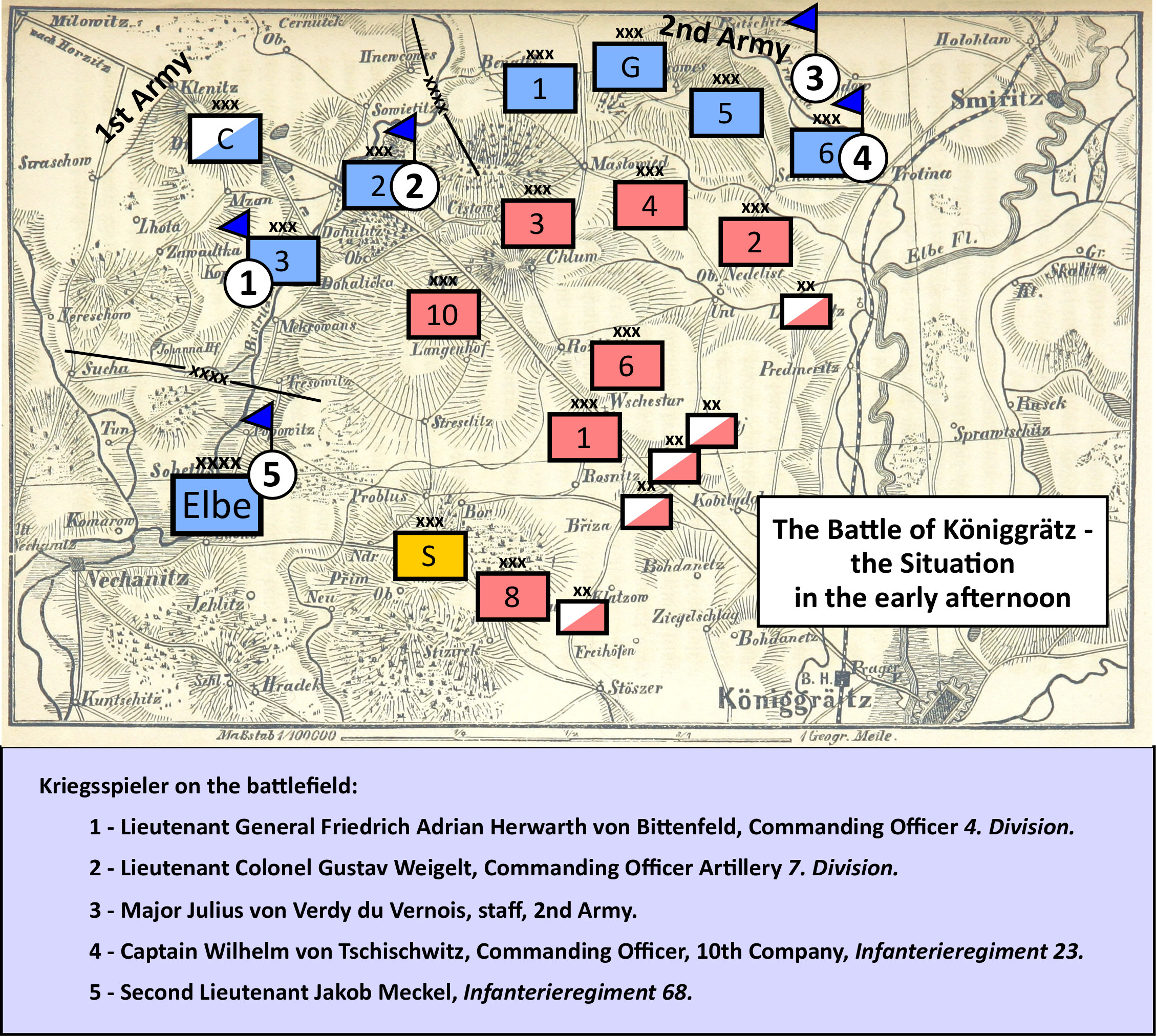
Kriegsspieler of the Month - The Battle of the Kriegsspielers
This is a brief interlude in the Kriegsspieler of the Month series before we turn to Carl von Decker in two weeks’ time. While it does not cover a person relevant to Kriesspiel history, it focuses on a single key event that features prominently in the history of quite a number of Kriegsspielers.
On July 3, 1866, the war between Prussia and Austria and its allies culminated in the Battle of Königgrätz. After a campaign of around four weeks which saw the allied forces suffering a series of ever-increasing setbacks, July 3 finally found the Austrian army together with its Saxon allies facing three Prussian armies. While the Prussians, having taken the risk to march separately towards Königgrätz, were numerically significantly inferior during the early hours of the day, by the early afternoon the tide of battle was turning decisively against the Austrians, with the Second Prussian Army arriving just in time to attack an Austrian right flank that had been significantly weakened by prior actions during the day. Eventually, Austrians and Saxons gave way, losing nearly 44,000 men or almost one fifth of their overall strength in dead, wounded and captured, and leaving the road to Vienna wide open.
The war was also fought in Germany as well as in Northern Italy: in cooperation with Baden and Württemberg forces the Bavarian army unsuccessfully tried to stem the advance of the Prussian army which earlier on had knocked out Hanover from the war, but suffered a significant defeat in the Battle of Bad Kissingen on July 10. Prussia’s ally Italy suffered two major defeats on land at Custoza and at Sea near the island of Lissa, but the Battle of Königgrätz effectively decided over the outcome of the war which ended less than two months later with the Peace of Prague.
The campaign leading up to it and the battle itself are of considerable interest to the military historian for a variety of reasons, many of which are quite obvious. It was the first major peer-level campaign the Prussian army had fought since the Napoleonic period, it was the first time the Prussian army reforms of the 1840s and 1850s were put to the test and it was the first major conflict pitting different types of technology against each other, with Prussian infantry using breech-loading needle rifles against Austrian rifled muzzle loaders, while Austrian artillery employed exclusively rifled breechloaders against opponents still partly equipped with smoothbore muzzle loaders. Also, the battle and indeed the whole Prussian campaign in Germany as well as in Bohemia proved many experts and pundits at the time wrong, who had expected the established military power Austria to prevail over upstart Prussia.
One aspect of the battle that rarely gets attention is its somewhat peculiar position in the history of the Prussian Kriegsspiel. On the one hand the whole campaign had some influence on the developing of the Kriegsspiel itself; Wilhelm von Tschischwitz, the most prolific rules designer, publishing an updated version of his original 1862 rules in 1867, and the battlefield itself became the scene of Kriegsspiele, with a large Kriegsspiel map produced shortly after the war (which is one of the very few surviving Kriegsspiel maps). On the other hand the battle was the one single incident in the history of the Kriegsspiel where four different generations of rules designers came together, making the Battle of Königgrätz the “Battle of the Kriegsspielers”.
The map below is based on a near-contemporary map of the battlefield published in 1868 (H. Blankenburg, Der deutsche Krieg von 1866, Leipzig 1868, Kartenbeilage 1). It shows very roughly - and without great detail - the position of five key figures from Kriegsspiel history on July 3, four rules designers and one key Kriegsspiel theoretician.

The oldest Kriegsspieler on the battlefield was Friedrich Adrian Herwarth von Bitterfeld, who was one of the original group of officers around the Kriegsspiel’s inventor. A lieutenant general at the time, he commanded 4. Division during the battle, which was part of III. Corps and involved in fighting around the Holawald, supporting 8. Division’s push towards Austrian lines. Further to the Northeast, lieutenant colonel Gustav Weigelt, who in 1848 had written a set of Kriegsspiel rules that circulated in the Magdeburg garrison, was serving as the commander of 7. Division’s artillery, and involved in heavy fighting in the Swipwald. Opposite the Austrian right flank, the already mentioned Wilhelm von Tschischwitz served as a young company commander with Infanterieregiment 23, part of VI. Armeekorps. In the same area, major Julius von Verdy du Vernois, the later Prussian minister of war and an important Kriegsspiel theoretician, served with the staff of the Second Army. And on the Austrian left flank, second lieutenant Jakob Meckel, who a decade later would produce what is arguably the most important piece of theoretical Kriegsspiel literature, the “Studien über das Kriegsspiel”.
So much for the tale of the Kriegsspieler battle. All five Kriegsspieler will eventually be covered in this series, which will continue soon with Carl von Decker.